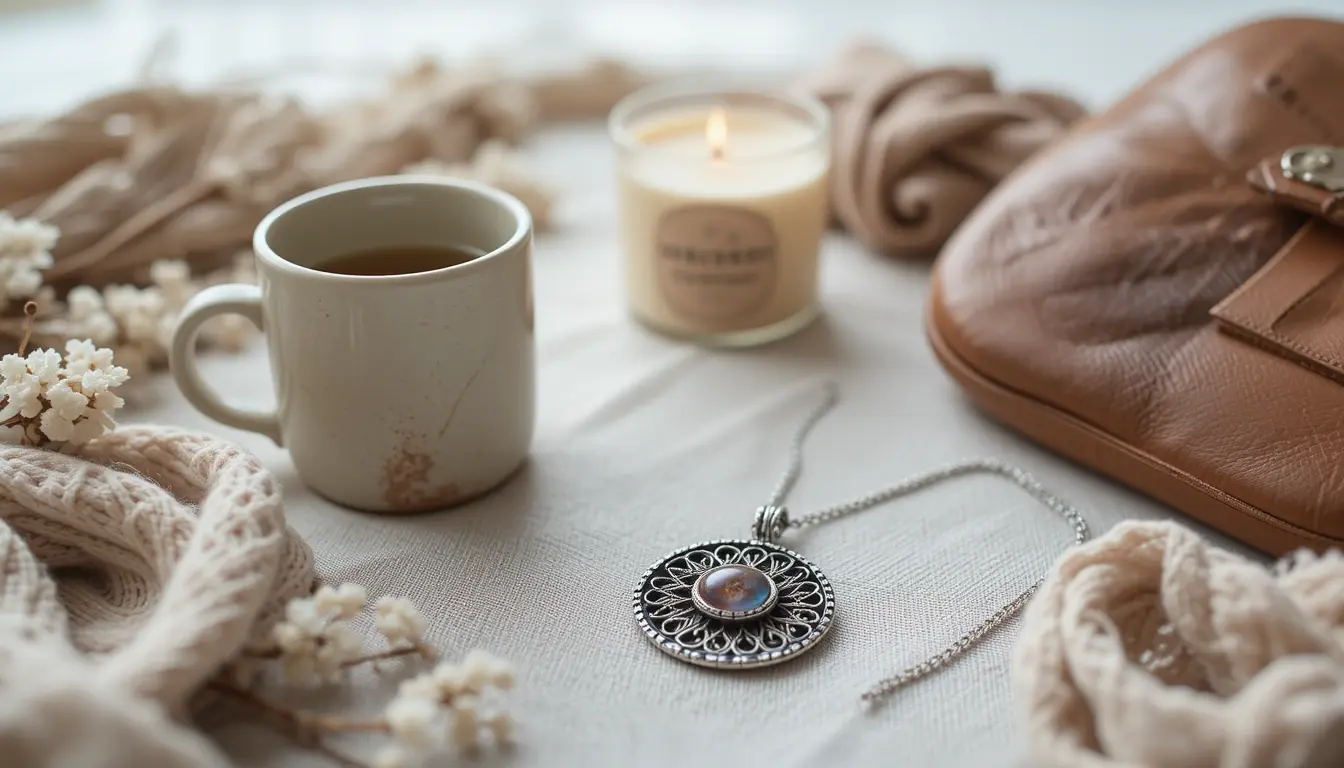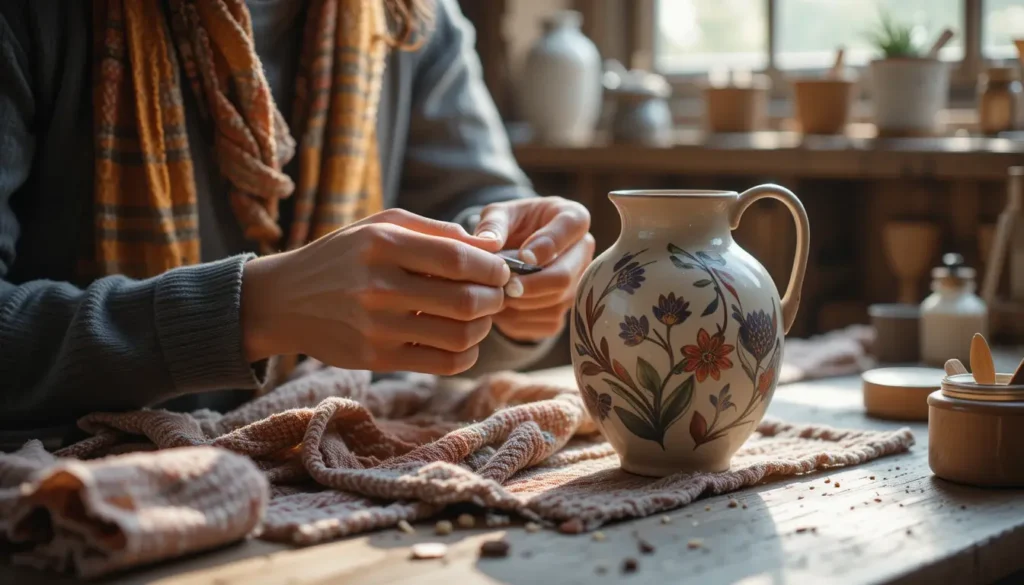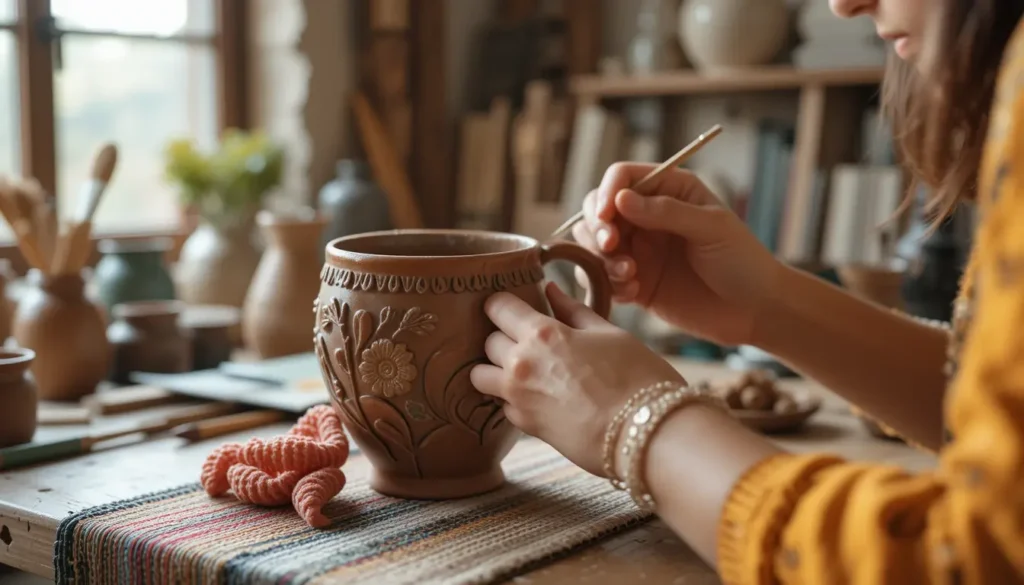Introduction
Are you tired of giving or receiving generic gifts that lack soul?
Or, as an artisan, do you find yourself pouring heart and hours into your creations, only to struggle to get them into the hands of buyers who truly appreciate their worth?
The search for unique and meaningful gifts for women can feel like a maze crowded with mass-produced options, unclear quality, and uncertainty about whether your purchase truly supports ethical, sustainable practices. For artisans, the challenge is just as daunting: how do you price your work fairly, market it authentically, and connect with the right audience in a competitive space?
That’s where The Artisan’s Compass comes in.
This comprehensive dual guide is crafted for two audiences united by a shared love of craftsmanship:
- Thoughtful gift-buyers who want every present to carry meaning, beauty, and a story.
- Passionate artisans ready to turn their skills into a thriving business without compromising quality or ethics.
Here, you’ll discover how to identify, choose, and present handcrafted gifts for her that truly resonate and how to successfully create, price, and sell your own handmade treasures with confidence and clarity.
The Enduring Appeal of Handcrafted Gifts for Her
What makes a handcrafted gift so special? It’s more than the beauty you can see it’s the story you can feel.
- The emotional connection: Each handmade item carries the artisan’s vision, skill, and care, transforming it into more than a product it’s a piece of someone’s heart and history.
- Standing out in a mass-produced world: While machine-made goods blur together, handcrafted gifts remain timeless, personal, and infused with individuality.
- A deeper bond: The giver, recipient, and artisan are linked through shared values authenticity, sustainability, and appreciation for the art of making.
In a marketplace often driven by speed and uniformity, handcrafted gifts offer something enduring: the human touch that can’t be replicated by any factory line. This guide will help you embrace that value, whether you’re choosing a special present or creating one yourself.

Part 1: The Buyer’s Comprehensive Guide to Handcrafted Gifts for Her
Understanding Her & Her Style: Choosing the Perfect Handcrafted Fit
The key to finding a handcrafted gift she’ll treasure is understanding her essence. A truly special present reflects not only her taste but also her lifestyle and values.
Actionable Steps:
- Observe her style: Look at the colors, textures, and patterns she wears, and notice her home décor. Does she favor clean lines or vibrant patterns?
- Consider her passions: Does she love gardening, reading, yoga, cooking, or travel? Gifts that connect to her hobbies show thoughtfulness.
- Think about personality: Is she minimalist, bohemian, classic, or adventurous? Each personality leans toward different styles of handmade goods.
- Ask subtly: Friends or family can offer insights you might miss.
- Define the “why”: Decide what message you want the gift to send love, gratitude, encouragement, or celebration.
Interactive Gift Personality Quiz
To make your search easier, this short quiz helps you identify her gift “style profile” in minutes.
Concept:
- Format: 5–7 quick multiple-choice questions.
- Purpose: Narrow down gift categories based on personality, interests, and relationship to the recipient.
- Example Questions:
- Her ideal Saturday is…
- Browsing vintage markets
- Hiking in nature
- Hosting friends at home
- Relaxing at a spa
- When it comes to jewelry, she…
- Loves bold, colorful statement pieces
- Prefers delicate, minimal designs
- Chooses meaningful charms or symbols
- Her favorite color palette is…
- Earthy tones and neutrals
- Pastels and soft shades
- Jewel tones and metallics
- Which of these would make her smile most?
- A handwoven blanket
- A custom-engraved bracelet
- A hand-painted mug
- A framed art print
- Her ideal Saturday is…
Sample Quiz Results & Categories:
- Mostly A’s → Boho Chic Jewelry
- Mostly B’s → Minimalist Everyday Accessories
- Mostly C’s → Cozy Home Textiles
- Mostly D’s → Statement Art Pieces

Types of Handcrafted Gifts & Their Unique Charm
Handcrafted Jewelry Distinctive designs, precious metals, and artisanal stones. Charm: Personal expression and heirloom potential.
Home Décor & Textiles Pottery, ceramics, woven blankets, wall art. Charm: Adds warmth, personality, and artisan flair to living spaces.
Apparel & Accessories Scarves, bags, knitwear, custom clothing. Charm: Sustainable fashion with a unique style statement.
Art & Illustrations Paintings, prints, sculptures. Charm: Emotional resonance and an investment in creativity.
Personalized & Custom Items Engraved keepsakes, custom portraits, bespoke crafts. Charm: One-of-a-kind connection and unmatched thoughtfulness.
Other Unique Categories Soaps, candles, gourmet foods, stationery. Charm: Everyday luxury and sensory delight.
Where to Find Authentic Handcrafted Gifts
Online Marketplaces:
- Etsy: Huge selection and a trusted review system. Pros: variety, global reach. Cons: quality varies always check reviews.
- Specialized Artisan Platforms: Curated collections, higher quality control.
- Artist-Owned Websites (e.g., Shopify Stores): Direct support for the creator, often with backstory and process details.
Offline Opportunities:
- Local Artisan Markets & Craft Fairs: See quality firsthand, speak directly with makers.
- Artisan Studios & Boutiques: Unique, location-specific finds.
- Social Media Discovery: Instagram, Pinterest (visual search), and Facebook artisan groups.
Expert Tip: Always check artisan reviews, request clear material details, and confirm return policies before purchasing.

Evaluating Quality & Craftsmanship in Handmade Goods
Key Quality Indicators:
- Consistent stitching, finishing, and detailing.
- High-quality, durable materials.
- Precision and attention to detail.
- Sturdy, functional construction.
Common Red Flags:
- Rough edges or seams.
- Uneven sizing or shape.
- Flimsy materials.
- Lack of material description.
| Gift Category | Key Quality Indicators | Red Flags to Watch For |
| Jewelry | Secure clasps, smooth soldering, even stone setting, hallmarking, genuine gemstone clarity/cut. | Weak clasps, visible glue, rough edges, inconsistent stone size/color, flaking plating. |
| Textiles/Fiber Art | Even stitching, strong seams, consistent weave/knit tension, natural dyes, high-quality feel. | Loose threads, uneven stitching, faded dyes, chemical smell. |
| Pottery/Ceramics | Even glaze, smooth finish, no cracks, solid weight, food-safe glaze. | Uneven glaze, cracks, rough bottoms, overly light or brittle feel. |
| Woodworking | Smooth sanding, tight joins, natural grain highlighted, durable finish. | Rough patches, loose joints, uneven stain, chemical odor. |
| Leather Goods | Strong stitching, genuine leather texture/scent, durable hardware, clean edges. | Plastic feel, peeling surface, loose stitching, cheap hardware. |
| Candles & Soaps | Even burn/melt, quality fragrance oils, clean ingredients list, sturdy container. | Sooty burn, overpowering synthetic scent, unlabeled ingredients. |
Expert Tip: Don’t hesitate to ask the artisan about materials and methods it’s both a sign of genuine interest and a way to verify authenticity.
The Art of Personalization & Presentation
Adding a Personal Touch:
- Engrave her initials, a date, or a short quote.
- Include a handwritten note for emotional impact.
- Choose something tied to a shared memory or inside joke.
Presentation Matters:
- Wrap with high-quality paper, ribbons, or natural elements like dried flowers.
- Use custom boxes or fabric gift bags.
- Include care instructions for the handmade piece.
Expert Tip: Share the artisan’s story with the gift it transforms the object into a meaningful connection.
Ethical Gifting: Supporting Artisans & Sustainable Practices
- Support conscious consumerism by choosing fair trade or direct artisan partnerships.
- Look for makers who use eco-friendly materials and low-impact production methods.
- Buying from small, independent creators means your money has a direct impact on their livelihood.
Expert Tip: Supporting local artisans often results in higher quality, unique designs, and a stronger community connection.
Common Buyer Pain Points & Solutions
| Pain Point | Solution |
| Finding truly unique, high-quality handcrafted gifts. | Use niche artisan marketplaces and local craft fairs; seek limited editions or custom pieces. |
| Uncertainty about fair pricing. | Understand time, skill, and materials; value the story behind the piece. |
| Difficulty assessing authenticity and ethical sourcing. | Ask makers directly, check reviews, look for certifications. |
| Feeling overwhelmed by too many or too few options. | Apply “Understanding Her Style” or take the “Gift Personality Quiz.” |
| Concerns about durability. | Review quality indicators, read descriptions carefully, check warranty/return policies. |
Avoid Common Pitfalls: Be cautious with sellers lacking clear photos, material details, or verified customer reviews.
Part 2: The Seller’s Essential Guide to Selling Handcrafted Gifts for Her
Identifying Your Niche & Target Audience for Handmade Gifts
Before you can sell your creations successfully, you need to understand exactly who you’re selling to and why they’ll choose your work over mass-produced alternatives.
Understand Your Buyer
The woman who buys handcrafted gifts often values:
- Authenticity: She wants products with a story, not something off a conveyor belt.
- Aesthetics: She seeks beauty, creativity, and individuality in every purchase.
- Ethical Standards: Sustainability and fair trade matter to her.
- Income Level: She is willing to pay more for quality, provided she understands the value.
Define Your Unique Selling Proposition (USP)
- What makes your work impossible to replicate? It could be your signature style, unusual materials, cultural inspiration, or customization options.
- Think beyond “I make handmade jewelry” and focus on specifics, e.g., “Minimalist gemstone jewelry inspired by coastal landscapes.”
Research Market Trends
- Use platforms like Etsy Trends, Pinterest, and Instagram to spot rising styles, seasonal color palettes, and popular categories.
- Attend local markets to see what’s selling and what’s missing.
- Track consumer interest in sustainability, personalization, and functional art.
Differentiation Opportunity:
By pairing this seller’s section with the buyer’s guide, The Artisan’s Compass becomes a rare, two-sided resource allowing readers to see both perspectives and understand what truly connects creators with customers.
Pricing Your Handmade Creations for Profit & Value
Pricing handmade goods isn’t about guessing or matching the lowest price online it’s about calculating costs, factoring in your time, and confidently communicating why your work is worth every penny.
Step 1: Calculate Your True Costs
- Materials: Include everything from raw supplies to packaging.
- Labor: Pay yourself for the time you spend creating track hours to be accurate.
- Overheads: Studio rent, utilities, tools, website hosting, marketing, and market stall fees.
Step 2: Choose the Right Pricing Strategy
- Cost-Plus Pricing:
Add a profit margin (commonly 2–3× materials + labor) to ensure you cover expenses and make a profit. - Competitive Pricing:
Compare similar artisan work, but don’t undervalue yourself use it to position your brand, not to race to the bottom. - Value-Based Pricing:
Price based on perceived value the craftsmanship, uniqueness, story, and emotional connection your piece creates. This often allows for higher margins.
Step 3: Communicate the Value
Customers are more willing to pay premium prices when they understand:
- The hours of work involved.
- The skill and training required.
- The uniqueness of each piece.
- The ethical and sustainable practices you follow.
Expert Tip: Never price solely to “beat the competition.” Your time, expertise, and creativity are assets price accordingly so your business can thrive.
Seller Pain Point: “I struggle to price my crafts competitively yet profitably.”
Solution: Break down your costs, choose a pricing model that reflects both skill and market demand, and educate your buyers through storytelling, behind-the-scenes content, and transparency about your process.
Showcasing Your Work: Photography & Product Descriptions That Sell
In the world of handmade goods, first impressions often happen online which means your photos and words must work together to capture attention and convey value.
Product Photography Best Practices
Your photos are your silent salespeople. Poor lighting or blurry shots can make even the most stunning piece look unremarkable, while a well-composed image can elevate its perceived value instantly.
Key Tips for Artisan Product Photography:
- Use High-Resolution Images: Ensure clear focus and crisp detail whether you use a DSLR, mirrorless camera, or a high-quality smartphone.
- Leverage Natural Light: Soft daylight brings out true colors and textures without harsh shadows.
- Show Multiple Angles: Include front, side, and back views to give a complete picture.
- Include Lifestyle Shots: Show the product in use or in a styled environment to help buyers imagine it in their own lives.
- Capture Detail Shots: Highlight craftsmanship, textures, and special touches.
- Provide Scale References: Include an object or hand in the frame so customers can visualize size.
Product Recommendation: For optimal results, use a DSLR or mirrorless camera. If that’s not feasible, many smartphones with portrait mode and manual settings can still produce professional-quality shots.
Expert Tip: Mastering product photography is non-negotiable. High-quality images build trust, communicate quality, and set you apart in a crowded handmade market.
Crafting Compelling Product Descriptions
A photo draws them in, but your words close the sale. The right product description doesn’t just inform it transports the reader into your creative world.
Essential Elements of a Great Product Description:
- Tell the Story: Share the inspiration, creative process, and meaning behind the piece.
- Highlight Unique Features: Explain what sets your item apart from similar products.
- Use Sensory Language: Evoke texture, weight, scent, or mood to help buyers imagine the experience.
- List Clear Details: Include dimensions, materials, and care instructions for transparency.
- Focus on Benefits, Not Just Features: Instead of just saying “wool scarf,” you could say “Luxuriously soft merino wool scarf that keeps you warm without the weight.”
Expert Tip: Buyers aren’t only purchasing an object they’re buying your artistry and the emotion it carries. Make sure your descriptions reflect that.

Choosing Your Sales Platform: Online vs. Offline Strategies
Where you sell can be as important as what you sell. The right platform connects you to your ideal audience, fits your workflow, and supports your long-term goals.
Online Platforms
- Etsy
- Pros: Large, built-in audience; quick setup; trusted by buyers.
- Cons: High competition; platform fees; less control over branding.
- Best For: Beginners looking for immediate exposure and artisans who want to test products before investing in a personal store.
- Your Own E-Commerce Store (e.g., Shopify)
- Pros: Full control over branding, pricing, and customer experience.
- Cons: Requires marketing effort and upfront setup time/cost.
- Best For: Established artisans ready to build a standalone brand presence.
- Social Media Selling (Pinterest & Instagram)
- Pros: Low-cost; direct customer engagement; highly visual platforms.
- Cons: Limited e-commerce features; requires consistent posting and engagement.
- Best For: Driving traffic to your store and building a loyal audience.
Offline Platforms
- Craft Fairs & Markets
- Pros: Personal interaction with customers; instant feedback; chance to tell your story face-to-face.
- Cons: Time-intensive; weather-dependent; booth fees may apply.
- Best For: Testing new products and building local brand awareness.
- Local Boutiques & Consignment Shops
- Pros: Expands your reach; offers ongoing exposure without direct selling.
- Cons: Lower profit margins; inventory management required.
- Best For: Artisans who want steady sales through established retail channels.
Multi-Channel Selling Strategy
Don’t rely solely on one sales outlet. A multi-channel approach for example, selling through Etsy, your own website, and local markets diversifies income streams, builds brand recognition, and reduces risk if one channel underperforms.
Packaging & Shipping Handcrafted Delights Safely and Beautifully
Your product’s journey doesn’t end at checkout it continues in the hands of postal workers, across miles of roads, and finally into the hands of your customer. Packaging and shipping are not just logistical steps they are opportunities to protect, delight, and strengthen your brand identity.
Secure Packaging
Handmade goods often involve delicate craftsmanship, so safeguarding them in transit is essential.
Best Practices for Secure Packaging:
- Choose the Right Box or Mailer: Use sturdy, appropriately sized boxes to prevent movement.
- Add Cushioning: Bubble wrap, corrugated inserts, or eco-friendly packing peanuts protect fragile details.
- Seal Strongly: Heavy-duty packing tape ensures the package remains intact.
- Test Your Packaging: Give it a gentle shake nothing inside should shift.
Cost-Effective Shipping
Keeping shipping affordable without sacrificing reliability builds trust and encourages repeat purchases.
Tips for Cost-Effective, Reliable Shipping:
- Compare carriers (e.g., USPS, UPS, FedEx, local couriers) for your package sizes and destinations.
- Use online postage services to save on retail shipping rates.
- Factor shipping costs into your product pricing to avoid sticker shock at checkout.
- Offer multiple shipping options, including express and standard delivery.
The Unboxing Experience
The unboxing moment is where buyers emotionally connect with your brand and where you can create a lasting impression.
Ways to Elevate the Experience:
- Branding Elements: Include a logo sticker on the package, a printed thank-you note, and a business card for easy referrals.
- Aesthetic Touches: Wrap items in soft tissue paper, tie with ribbon, or include dried flowers for a sensory surprise.
- Personalized Notes: Address the customer by name, mention the item purchased, and express genuine gratitude.
Expert Tip: Customers often share beautiful unboxings on social media and that’s free marketing. A small investment in presentation can multiply your brand visibility.
Building a Brand & Connecting with Buyers: Storytelling & Customer Service
Branding is not just a logo it’s the promise and personality your customers experience with every interaction.
Developing Your Brand Identity
- Logo & Brand Colors: Choose a palette and mark that reflects your craft’s personality modern minimal, rustic organic, or vibrant artisanal.
- Consistent Voice: Write and speak in a tone that matches your brand whether that’s warm and heartfelt or sleek and sophisticated.
- Visual Consistency: Use the same photography style, font choices, and layout across platforms.
The Power of Storytelling
Storytelling humanizes your brand and deepens customer loyalty.
Ways to Share Your Story:
- Talk about how you discovered your craft.
- Share behind-the-scenes glimpses of your creative process.
- Highlight the inspiration and meaning behind each collection.
Expert Tip: Social media is your open studio use it to share not just products, but moments of making, inspiration, and even challenges.
Exceptional Customer Service
Customer service is your most powerful marketing tool, often more effective than paid ads.
Golden Rules:
- Respond to inquiries within 24 hours.
- Handle returns and exchanges graciously, even when inconvenient.
- Follow up after purchase to ensure satisfaction.
- Use feedback to improve and thank customers for it.
Artisan Success Story
Case Study: The Journey of “Willow & Thread” Handmade Jewelry for the Modern Minimalist
When Sarah Martinez started “Willow & Thread,” she was a teacher by day and a jewelry artisan by night. Her niche? Delicate, minimalist jewelry designed for women who valued both elegance and everyday wearability.
Challenges She Faced:
- Pricing her work to reflect both quality materials and the hours of meticulous hand-finishing.
- Finding an audience that valued minimalism in a market flooded with statement pieces.
Marketing Strategies She Used:
- Instagram Storytelling: Documenting each piece’s creation from raw metal to finished necklace.
- Styled Product Photography: Showing her jewelry in real-world outfits to inspire buyers.
- Multi-Channel Sales: Etsy for initial reach, Shopify for brand control, and occasional pop-up events for local engagement.
Key Advice from Sarah:
“Don’t be afraid to charge for your time and skill. People aren’t just buying a necklace they’re buying the years you spent mastering your craft.”
Today, Sarah’s work ships worldwide, with repeat customers making up 40% of her sales. Her success lies in consistent branding, heartfelt storytelling, and treating each customer like a collaborator in her creative journey.
Common Seller Pain Points & Proven Solutions
Even the most talented artisans face challenges when turning their craft into a thriving business. Understanding these common hurdles and how to overcome them can save time, money, and frustration.
Pain Point #1: Struggling to Price Crafts Competitively Yet Profitably
The Challenge: Many artisans underprice their work, fearing they’ll lose buyers to cheaper, mass-produced items.
The Solution:
- Comprehensive Cost Calculation: Include materials, labor (hourly rate for your time), and overheads like tools, workspace, and marketing.
- Market Value Research: Compare prices for similar handmade items but avoid competing solely on price.
- Communicate Your Value: Use product descriptions, branding, and storytelling to explain why your handcrafted piece is worth more than a factory-made alternative.
Expert Tip: If your audience understands the hours of skill and care invested, they’ll see your price as an investment, not an expense.
Pain Point #2: Challenges in Effectively Marketing and Reaching the Right Buyers
The Challenge: Without a clear marketing strategy, even the most beautiful products can go unnoticed.
The Solution:
- Optimize Product Photography & Descriptions: High-quality visuals and compelling stories draw buyers in.
- Leverage Social Media Storytelling: Platforms like Instagram and Pinterest are perfect for showing the personality behind your brand.
- Explore Diverse Sales Channels: Combine online platforms (Etsy, Shopify) with offline opportunities (craft fairs, pop-up markets) to widen your reach.
Pain Point #3: Ensuring Consistent Quality and Efficient Production
The Challenge: As orders increase, so does the risk of rushed work or quality slip-ups.
The Solution:
- Establish Production Processes: Create a checklist or step-by-step workflow for each product.
- Source Reliable Materials: Build relationships with suppliers to ensure consistent quality.
- Batch Production: Make multiple items or components at once to save time without sacrificing craftsmanship.
Pain Point #4: Navigating Online Marketplaces for Handmade Goods
The Challenge: Each platform has its own rules, algorithms, and competition level, which can feel overwhelming.
The Solution:
- Research Platform Rules: Avoid costly mistakes by knowing each site’s policies on shipping, returns, and fees.
- Optimize for Search: Use targeted keywords in titles, descriptions, and tags to improve visibility.
- Engage in Platform Communities: Participate in forums, groups, or co-promotions to build trust and increase exposure.
Common Pitfalls to Avoid as a Handmade Seller
Learning from others’ mistakes can fast-track your success. Avoid these traps:
- Underpricing Your Work This undervalues your skill and sets unsustainable expectations.
- Neglecting Marketing Relying solely on “word of mouth” limits your growth potential.
- Inconsistent Branding Mixed messages or visuals make it harder for customers to remember and trust you.
- Ignoring Customer Feedback Even constructive criticism can reveal areas for improvement.
- Overextending Too Quickly Expanding product lines or platforms before you’ve built a steady base can dilute quality and focus.
Conclusion: The Future of Handcrafted Gifting
In a world overflowing with mass-produced options, handcrafted gifts stand apart carrying not only beauty and function but also a story, a connection, and a sense of purpose.
For buyers, this guide has shown that thoughtful gifting isn’t about price tags or trends; it’s about finding unique, ethically made treasures that reflect the recipient’s personality and values. For sellers, we’ve explored how to turn passion into a sustainable business from pricing and marketing to branding and creating an unforgettable customer experience.
The future is bright for artisanry. As more people seek sustainable, conscious consumer choices, they’re rediscovering the joy of supporting skilled makers and small businesses. This isn’t just a passing trend it’s part of a broader cultural shift towards authenticity, quality, and human connection.
Handcrafted gifts preserve traditional skills while evolving with modern tastes. They bridge the gap between giver, recipient, and creator forging bonds that no factory line can replicate. Every purchase is more than a transaction; it’s an investment in artistry, heritage, and a more personal way of living.
Your Call to Action: Whether you’re seeking the perfect handcrafted gift for her or creating one with your own hands, you’re part of a vibrant community shaping the future of meaningful gifting. Support artisans, share their stories, and let every gift you give or sell be a testament to creativity, care, and connection.
